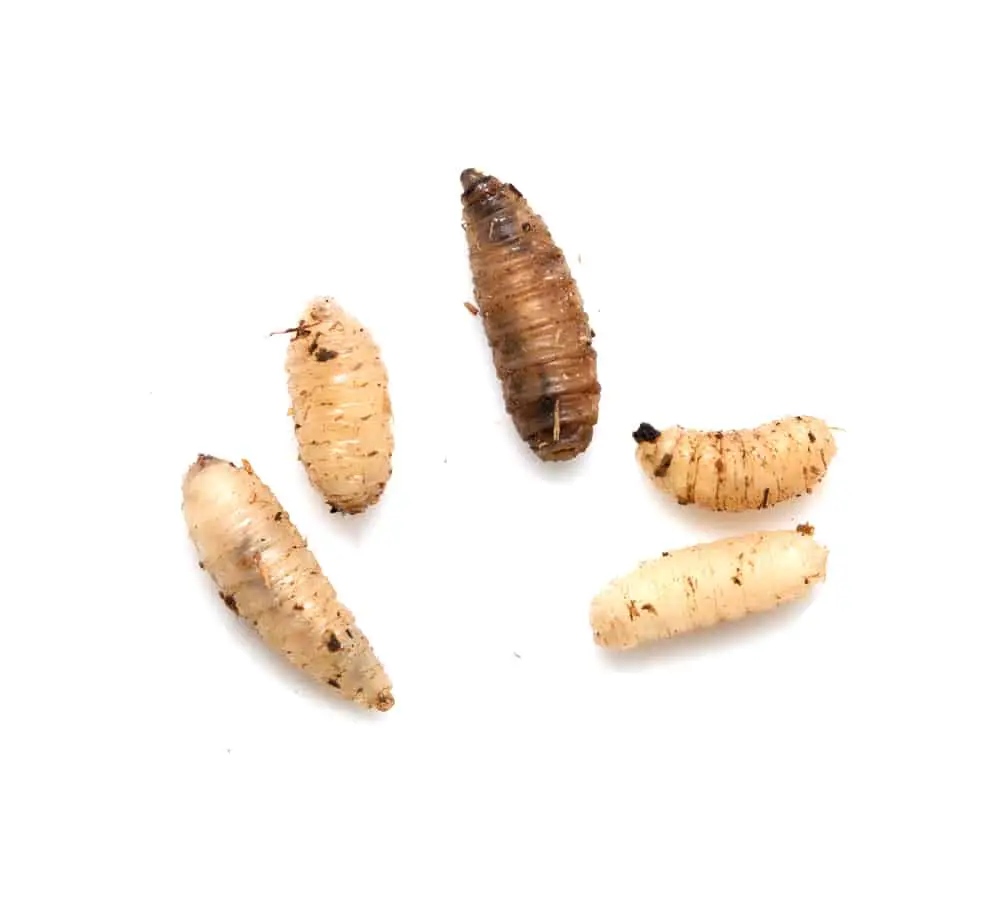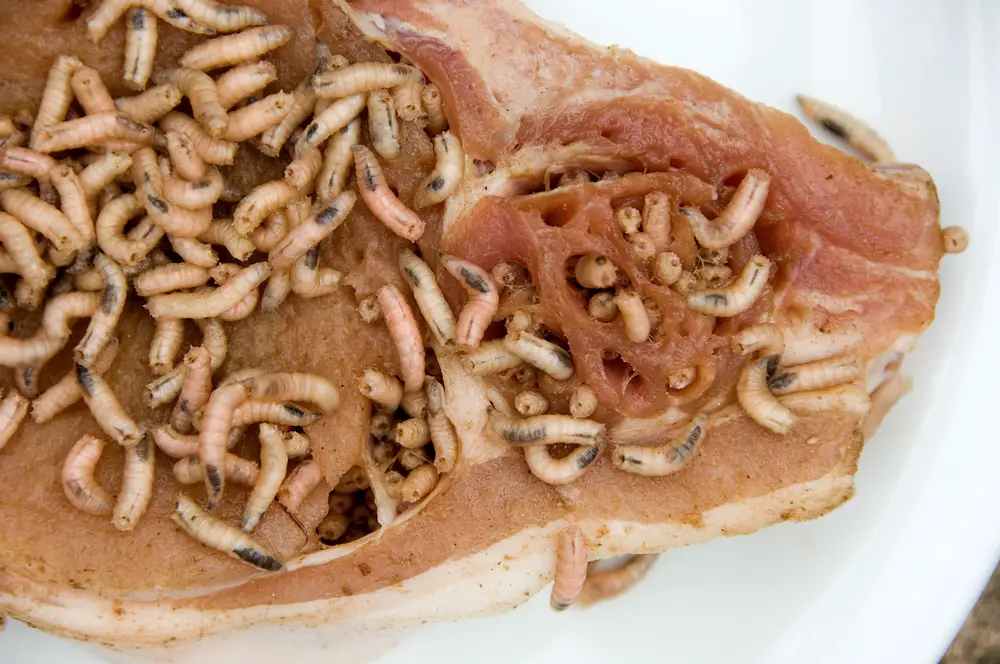Maggots, the larvae of flies, are often associated with decaying organic matter and unclean environments.
However, many people are baffled by the appearance of maggots, even in seemingly sanitized areas with no apparent presence of adult flies. This peculiar phenomenon seems to defy a basic understanding of the life cycle of flies.
Quick Answer:
Maggots do not form without flies. They are the larval stage of flies, and flies lay eggs on decaying organic matter. If you find maggots without adult flies present, it’s likely that the flies laid their eggs in a hidden or inaccessible area, and the maggots emerged later when conditions became suitable for their development. This dispels the notion of spontaneous generation.
Flies, like any other insects, have distinct stages in their life cycle, which include egg, larva, pupa, and adult.
Despite their absence being seemingly conspicuous, the adult flies may have laid eggs in inconspicuous locations, often unnoticed by humans.
Additionally, the incubation period of fly eggs varies depending on the species, temperature, and humidity, which may affect the visible presence of maggots.
Maggot Formation Process
Eggs and Hatching
Flies lay their eggs on decaying organic matter, which serves as a food source for the developing larvae. The warm and moist conditions provided by the decaying matter serves as an ideal environment for the eggs to incubate and hatch.
After about 24 hours, the eggs hatch into maggots, or the larval stage of the fly’s life cycle.
Larval Stage and Development
Maggots are the larval stage of flies, and their primary function is to consume the decaying organic matter in which they hatched. They have soft, white, segmented bodies and are legless.
The larvae go through three stages of development called instars. During each instar, maggots will molt, shedding their old skin and growing a new one in order to accommodate their increasing size.
The development stages are as follows:
- First instar: The newly hatched maggots are approximately 1-2 mm in length and have a feeding period that lasts 1-2 days.
- Second instar: The maggots grow to around 3-4 mm and continue to feed for 2-3 more days.
- Third instar: In this final larval stage, maggots grow up to 8-12 mm and feed for 3-5 additional days.
Throughout these stages of development, maggots consume organic material, break it down, and play an important part in the process of decay.
Pupae and Transformation to Flies
After completing the larval stages, maggots will search for a safe and dry place to enter the pupa stage, which is the final step before emerging as adult flies. During this stage, the larvae’s bodies become encased in a protective, hard outer shell called a puparium.
Inside the puparium, the larva will undergo a process of metamorphosis, during which its body is restructured into an adult fly. This process usually takes about 7-14 days, depending on temperature and environmental conditions.
Once the metamorphosis is complete, the adult fly will emerge from the puparium and begin its life as a winged adult, ready to mate and repeat the life cycle by laying eggs on suitable decaying matter.
Environmental Factors in Maggot Formation

Decaying Organic Matter
Maggots form mainly on decaying organic matter, which provides them with the necessary food and breeding environment. This includes rotting material like dead animals, carcasses, spoiled food, and even some plant matter.
Maggots are particularly drawn to decomposing meat and corpses. They thrive in areas rich in organic matter, such as soil and garbage bins.
Temperature and Humidity
Temperature and humidity play crucial roles in maggot formation. Maggots require a warm and moist environment to grow and reproduce. They typically flourish in temperatures between 68 – 86°F (20 – 30°C).
Higher temperatures can speed up their development, while colder conditions may slow them down or even halt their growth entirely. Humidity is another critical factor, as maggots need moisture to survive. Dry environments can be harmful to them, while high humidity levels aid in their growth and reproduction.
Breeding Grounds
Breeding grounds for maggots are places where there is an abundance of decaying organic material and the necessary temperature and humidity conditions. These include locations such as soil, garbage bins, and the insides of dead animals.
For instance, maggots can often be found in outdoor trash cans, dirty kitchens, or around rotting plants and meat. By understanding these environmental factors, one can take preventive measures to minimize their presence and potential infestations.
Maggots in Nature
Role in Decomposition Process
Maggots are the larvae of various species of flies, such as houseflies and blowflies. They play an important role in the decomposition process, breaking down dead organic material and aiding in nutrient recycling.
They are most commonly found on decomposing animal carcasses but can also be found in decaying plant matter or garbage. When an adult fly detects the scent of a decomposing carcass, it lays its eggs, which eventually hatch into maggots.
Maggots consume the decaying material, releasing nutrients back into the ecosystem, which promotes the growth of bacteria and other organisms essential for the decomposition process. This ultimately helps to return the elements back to the soil and atmosphere, contributing to the natural circle of life.
Diet and Predators
The diet of maggots primarily consists of decaying organic matter. They possess a pair of mouth hooks that enable them to tear into the decomposing material and consume it. Maggots act like nature’s cleanup crew, helping to break down and dispose of carcasses, plants, or other organic matter.
As for the maggots themselves, they have plenty of predators. Birds, amphibians, and even certain insects like predatory maggots feast on them. Many of these creatures are attracted to the scent of decomposition, where they find maggots as a rich, protein-filled meal.
Forensic Science Applications
Maggots’ role in decomposition is not only valuable to the ecosystem but also to forensic science. By studying their presence, growth stages, and species, forensic entomologists can gather crucial information to estimate the time of death and determine possible causes of death in cases of unexplained or suspicious fatalities.
Blowflies are some of the first insects to arrive at a corpse, and their day-to-day differences in development stages can provide a fairly accurate timeline of the events surrounding death.
Forensic scientists also take into account factors such as surrounding environmental conditions, which affect maggots’ growth rates and can help further narrow down the time of death.
Common Maggot Infestations

Maggots are often associated with flies, as they are in the larval stage of various fly species. However, maggot infestations can occur in various situations without adult flies being present.
Let’s explore some common infestations and how they happen.
Household Pests
Maggots can be found in various household items, such as garbage cans, rotten food, and even damp, decaying materials. Fly eggs may be laid on these substances, with the incubation period usually lasting a day or two before hatching into maggots.
While it’s not ideal to find maggots in your home, they can help break down organic matter, playing an essential role in the decomposition process.
To eradicate maggot infestations in your home, ensure proper sanitation practices, such as:
- Regularly removing garbage
- Sealing food containers
- Cleaning up spills and messes
In Human Body
Maggots are also known to infest human tissues. Although rare, they can infiltrate the body through open wounds, the nose, or other bodily orifices. Once inside, the maggots feed on dead or dying flesh, which could lead to a medical condition called myiasis.
To prevent maggots infestation in the human body, practice good hygiene, such as:
- Regularly washing your hands
- Cleaning and covering open wounds
- Seeking medical attention for persistent infections
It’s essential to seek professional medical help if you suspect a maggot infestation in your body.
In Pets
Our furry companions, like dogs and cats, can also face maggot infestations. Flies or other insects might lay eggs on any open wounds, sores, or areas with matted fur, resulting in a maggot-infested wound.
Here are some ways to prevent maggot infestation in your pets:
- Routinely groom your pets, focusing on areas with matted fur
- Clean and treat any wounds on their skin
- Limit your pet’s exposure to trash or decaying organic materials
If you suspect a maggot infestation, consult a veterinarian immediately to ensure appropriate treatment and prevent complications.
Maggot Prevention and Control
Proper Food Storage
A vital step in maggot prevention is proper food storage. It is essential to store perishable items, such as fruits and grains, in sealed containers. This minimizes the chance of flies laying eggs on them.
It is also crucial to check the food for signs of infestation, including rice and other grains. Place the food in a cool, dry area to avoid attracting flies.
Cleaning and Sanitation
Maintaining a clean environment is crucial in controlling maggots. Regularly clean surfaces, such as countertops, floors, and other areas where food is prepared and consumed.
Pay close attention to areas prone to dampness or moisture. If you find maggots near a wound, it is vital to clean the affected area immediately and consult a doctor.
To sanitize surfaces effectively, you can use boiling water and bleach, which are effective in killing maggots and their eggs. Ensure that all waste is properly disposed of and that trash cans have a tight-fitting lid.
Chemical and Natural Treatments
There are several options for controlling a maggot infestation in your home. Chemical treatments, such as Raid, are effective in killing adult flies and maggots. However, these may contain toxic components.
As an alternative, consider natural treatments. Boiling water can be poured over maggots to kill them instantly. If dealing with fruit flies, use a protective mesh or cover over fruits to prevent infestation.
In cases of infestations specific to Calliphoridae (blowflies), consult a pest control expert for professional advice on how to handle the situation.
In conclusion, while it may appear that maggots can form without flies, the reality is that these small creatures are a natural part of the fly life cycle.
Understanding the link between flies and maggots allows for improved measures when it comes to managing waste, controlling fly populations, and preventing the appearance of maggots in unexpected locations.


